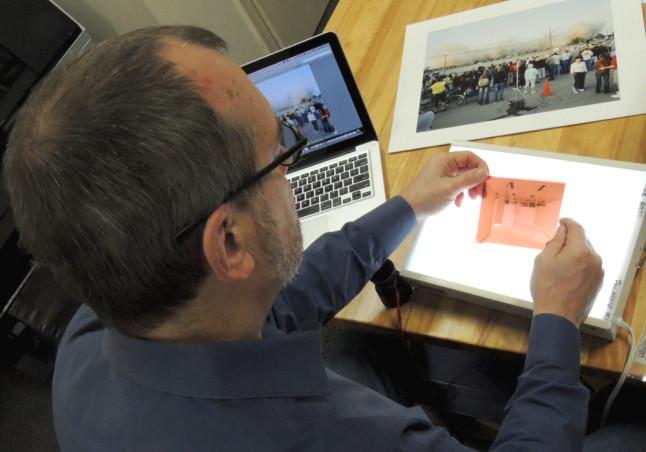By Emma Prestwich
When Robert Burley heard that Kodak Canada was shutting down its Toronto operations in 2005, he figured the multinational film giant was losing revenue due to new digital technology.
“I assumed that it was a kind of downsizing, that there was less demand for these products.” At the time, the Ryerson photography professor was still using film, the strips of transparent celluloid coated with light-sensitive chemicals that photographers have used to capture images for over a hundred years.
He had no idea how quickly the analog photography industry would begin to die.
Burley received permission to enter Kodak Canada’s facilities so he could photograph the massive buildings, filled with the soon-to-be obsolete machinery needed to make film and to develop it.
Then in 2007, when Kodak began demolishing buildings at one of its main sites in Rochester, New York, a facility that had employed thousands of people, the veteran photographer realized he needed to capture the end of an industry before it disappeared completely.
“My photographic heroes are artists who were really good at looking at their present day and understanding that something was changing around them,” he says. “This world I knew very well, to my surprise, was starting to change and disappear. I wanted to make a record of that.”
Over the next three years, he traveled across Canada, the U.S., France and Belgium, photographing implosions of abandoned factories belonging to Kodak, Agfa Gevaert, Polaroid and Ilford.
He even witnessed the botched implosion of the Kodak-Pathé building in Chalon-sur-Saône, France, the birthplace of Joseph Niépce, who developed the first method of photography in 1825.
“I was always shocked that this was really happening. To be there physically was a different experience from reading about it in the newspaper,” he says.
He compiled 71 of those photographs into a book called The Disappearance of Darkness. Published in October, it’s already sold out and on its second printing.
He credits the overwhelming response to the public’s realization that digital photography overtook film faster than anyone realized.
“It’s hard to imagine that these factories had anything to do with making photographs. How can these windowless structures have anything to do with making a picture on your iPhone?” He says the book chronicles not just the fall of an industry, but also a major shift in our relationship with images.
“It has changed from one created in darkness to one that has been changed by digital technology… one that involved data-driven devices, one that is no longer physical. Photography has been dematerialized.”
The rapid change meant a total overhaul of Ryerson’s photography program. About four years ago, when Burley was program chair, the department decided to emphasize digital as the primary method of taking photos, with analog as a secondary method of production.
“It’s a really interesting time to be involved in teaching, it’s very difficult to know what’s coming next and to be able to adapt to it,” he says. “A lot of [people] are coming into the program never having used film before.”
In 2005, during Burley’s tenure as program chair, Kodak Canada turned over its entire corporate archives to Ryerson’s special collections, along with the materials from the failed Kodak Canada Heritage Museum, which folded the same year the company did.
Burley says while he still uses both film and digital in his work, he doesn’t know how much longer he’ll be able to get ahold of the equipment he needs. The biggest buyer of film now is Hollywood, but many theatres have already switched to digital projection. No one knows how much longer the motion picture industry will be able to keep film companies afloat.
Although his book focuses on just one major industry shift, Burley sees a future in which creative professionals won’t be able to resist change.
“I see this as someone who’s teaching it, I don’t think anyone can work in a medium-specific field any longer.
It’s difficult to just be a photographer, we’re expected to have not just photographic skills. We all use the same tools.”










Leave a Reply